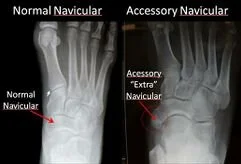
A step in the right direction
Podiatry Mackay Blog
Verrucae Pedis (‘Plantar Warts’)
Commonly known as plantar warts, Veruccae Pedis is caused by the Human Papilloma Virus (HPV).
Why did I get it?
Trauma induced exposure to the infection
Direct contact with virus
HPV thrives in warm, moist environments such as; footwear, swimming pools, changing room floors and bathrooms
Tibialis Posterior Tendinopathy
As the name suggests, Tibialis Posterior Tendinopathy is a condition that is characterised by degeneration of the Tibialis Posterior tendon. This tendon is arguably the most important stabilizer of the human foot, with its main role being to support the structural integrity of the arch.
Medial Tibial Stress Syndrome (‘Shin Splints’)
Medial Tibial Stress Syndrome (MTSS), or more commonly known as ‘Shin Splints’, is a chronic over-use injury that generally affects active individuals.
Sesamoiditis
Sesamoiditis is an ailment that affects the forefoot, typically in young people who engage in physical activity like running or dancing. The term is a general description for any irritation of the sesamoid bones, which are tiny bones within the tendons that run under the big toe.
Anterior Impingement Syndrome
Anterior Impingement Syndrome (AIS) is characterised by a build up of tissue (either bony or soft tissue) between two bones of the ankle joint; the Tibia and Talus. Due to this impingement, patients often present complaining of anterior (front of) ankle pain that is made worse with activities that require excessive movement of the ankle joint, e.g. Lunging, kicking and running. Anterior Impingement Syndrome is prevalent in all ages and gender, however, is most commonly seen in ballet dancers due to the amount of ankle movement that is required.
Retro-calcaneal bursitis
Bursa are small fluid filled sacs within the body and are primarily focused on cushioning and lubricating tendons as they pass over bone. As shown in the image below, the Retrocalcaneal Bursa is located between the heel bone (Calcaneus) and the Achilles tendon and is focused on providing this cushioning for everyday activities such as walking and running. However, either through direct trauma or a combination of risk factors, the Retro-calcaneal Bursa can become inflamed/irritated, resulting in a Bursitis. Symptoms of RCB include redness, swelling, stiffness and posterior heel pain (especially with direct pressure or going up on toes).
Accessory Navicular
An accessory navicular is an extra piece of bone or cartilage located in the tendon that attaches to the navicular bone on the inner side of your foot, near the arch. It’s not present at birth and can develop over time, often becoming symptomatic during adolescence when bones and cartilage are changing, but it can also cause issues in adulthood.
Fat Pad Syndrome
The fat pad is a protective shock absorber that sits between your heel bone (calcaneus) and the outer layer of your skin. The fat pads primary role is to reduce the amount of stress going through the heel while you walk/run. The fat pad is held together by small ligamentous structures that can occasionally rupture or elongate, causing the fatty tissue to spread out. As a result, the amount of cushioning present at the heel is reduced producing symptoms like a stone bruise.
Rheumatoid Arthritis and your Feet
Rheumatoid Arthritis is an auto-immune disease that can cause chronic inflammation of many different body systems. Primarily it affects joints but can also affect many different tissues and organs throughout the body. It is associated with joint destruction which can lead to pain, disability, loss of function, and overall reduce one’s quality of life.
Flexor Hallucis Longus (FHL) Tendinopathy
Flexor Hallucis Longus (FHL) is a muscle in your lower leg that is primarily focused on flexing the big toe and plantar flexing the ankle (points toes to ground) while walking/running. The muscle belly is in the deep compartments of your leg and its tendon runs past your inside ankle bone and inserts onto the base of the big toe. Occasionally, this muscle/tendon can be over-worked and begins to degenerate. This is known as Flexor Hallucis Tendinopathy (degeneration). Clinical features of the conditions are medial (inside) ankle pain, pain while standing on toes and pain with flexion of the big toe.
Plantar Fasciitis – aka ‘Heel Pain’
Plantar Fasciitis can be caused by many factors and is most seen in the active middle-aged population (women > men). Most patients with Heel pain can often relate to many of the following signs, symptoms & risk factors:
Pain when rising (especially in morning)
Incorrect footwear
Tight Calf muscles
Flat & High - arched feet
Prolonged standing especially on hard surfaces
Sudden increase in weight
Sudden change or increase in activity levels
Inter-metatarsal Bursitis
Intermetatarsal bursa are small fluid filled sacs that are located between the interossei muscles and metatarsal bones of the foot. Their main role is to act as a lubricant while the small muscles glide over the bone during movement. Due to the high workload of the foot, inter-metatarsal Bursa can occasionally become inflamed, hence the term; Intermetatarsal Bursitis. Common symptoms include pain while standing on toes, fore-foot (ball of foot) tenderness during rest and motion, as well as visible fore-foot swelling, burning sensations.
Knee Bursitis
Knee bursitis causes pain above, on top of and below the kneecap (patella). Bursa are small fluid filled sacs and allow tendons, muscles, and skin to slide over bony surfaces without causing damage, essentially helping to reduce friction in joints.
Patellofemoral Pain Syndrome
Patellofemoral Pain Syndrome (PFPS) or commonly known as ‘runner’s knee’, is an umbrella term that is associated with anterior (front of) knee pain, in the absence of other pathologies.
Lisfranc’s (mid-foot) joint injury
Lisfranc’s joint is the connection between the metatarsal and tarsal bones. This major load bearing joint consists of multiple ligaments that intertwine between the bones and is primarily concerned with maintaining the arch of the foot. A Lisfranc’s joint injury occurs when there is damage to one or more of these small ligaments, resulting in loss of the structure/strength of the mid-foot.
Medial Calcaneal Nerve Entrapment
The Medial Calcaneal nerve is a superficial branch of the Posterior Tibial nerve and innervates the skin of the inside portion of the heel. During movement of the foot/ankle, the nerve runs smoothly through its sheath (cover) and allows for adequate sensation beneath the heel. However, whether it be due to biomechanical issues or direct trauma, compression of this nerve can occur and produce discomfort. This condition is known as Medial Calcaneal Nerve Entrapment.
Osteoarthritis and the Feet
Osteoarthritis (OA) is a disease of the joints. The two bones of a joint are normally protected by smooth, cushioning material called cartilage. Osteoarthritis is often thought of as a 'wear and tear' disease. It causes the cartilage on the end of your bones to get rougher and thinner. The bone underneath makes up for this by thickening and growing outwards, creating outgrowths (osteophytes). These can make your joint appear knobbly. The capsule around the joint also thickens and becomes inflamed.
Onychogryphosis
Onychogryphosis is thickening of the nail/s that may produce them to resemble a "rams horn." Yellowish, brownish discolouration can occur also.
Morton's neuroma
A Morton’s Neuroma is a thickened nerve that presents between the long bones (metatarsals) of your foot. Although they can occur between any of these long bones, the most common location is between the 3rd and 4th metatarsal heads. Despite being variable between patients, the most common presenting complaints are burning, tingling and numbness within the area and it is not uncommon to feel referred pain into the toes.
Muscle Strain
A muscle strain occurs because of damage or over stretching of a muscle. In order to fully understand a muscle strain, it is helpful to understand what makes up a muscle. A muscle is covered in an outer lining or sheath. Inside the sheath are several bundles of muscle fibres which are again surrounded by an inner sheath. These muscle fibres can be broken down even further microscopically. As a muscle contracts these microscopic filaments link and slide together. When a muscle lengthens or shortness these filaments will slide apart. Therefore, it becomes a co-ordinated movement, principally from the brain, causing movement of a joint in one direction while lengthening and in the opposite direction as it shortens. Muscle strains most of the time happen during an eccentric muscle contraction (lengthening of a muscle) as this type of contraction controls or regulates movements of joints. Muscle strains generally are more common in sprinters or athletes who accelerate quickly from a stationary position. The muscle becomes overloaded and reaches a point where the sliding filaments cannot withstand the velocity of movement and a tear or partial tear will occur.




















